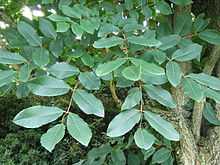Meliosma
| Meliosma | |
|---|---|
 | |
| Meliosma veitchiorum | |
| Scientific classification | |
| Kingdom: | Plantae |
| (unranked): | Angiosperms |
| (unranked): | Eudicots |
| Order: | unplaced |
| Family: | Sabiaceae |
| Genus: | Meliosma Blume |
| Species | |
|
See text | |
| Synonyms | |
|
Millingtonia Roxb. | |
Meliosma is a genus of flowering plants in the family Sabiaceae, native to tropical to warm temperate regions of southern and eastern Asia and the Americas. It is traditionally considered to contain about 100 species; some botanists[1] take a much more conservative view accepting only 20-25 species as distinct. They are trees or shrubs, growing to 10–45 m tall.
Fossil evidence shows the genus formerly had a much wider range in the Northern Hemisphere, including Europe and central Asia until the late Pliocene ice ages, and somewhat earlier in North America.[2]
The Indian Awlking (Choaspes benjaminii) is one of the Lepidoptera whose caterpillars feed on Meliosma; they have been found on M. pungens, rhoifolia, M. rigida, and M. squamulata.
Selected species
|
Asia
|
Americas
|
Footnotes
References
- van Beusekom, C.F. (1971): Revision of Meliosma (Sabiaceae), section Lorenzanea excepted, living and fossil, geography and phylogeny. Blumea 19: 355-529.
External links
- Flora of Pakistan: Meliosma
- Flora of China: Meliosma species list
- Flora of Ecuador: Meliosma
- IAC Herbarium (Brazil): Meliosma species list
- Germplasm Resources Information Network: Meliosma